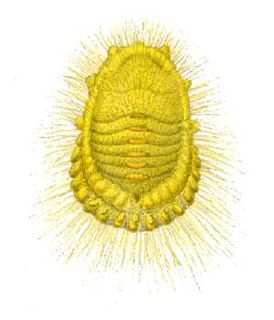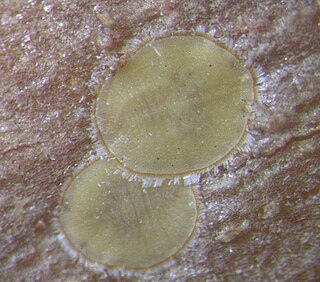
The Hemiptera or true bugs are an order of insects comprising some 50,000 to 80,000 species of groups such as the cicadas, aphids, planthoppers, leafhoppers, and shield bugs. They range in size from 1 mm (0.04 in) to around 15 cm (6 in), and share a common arrangement of sucking mouthparts. The name "true bugs" is sometimes limited to the suborder Heteroptera. Many insects commonly known as "bugs" belong to other orders; for example, the lovebug is a fly, while the May bug and ladybug are beetles.

The Sternorrhyncha suborder of the Hemiptera contains the aphids, whiteflies, and scale insects, groups which were traditionally included in the order Homoptera. "Sternorrhyncha" refers to the rearward position of the mouthparts relative to the head.

The Margarodidae or ground pearls are a family of scale insects within the superfamily Coccoidea. Members of the family include the Polish cochineal and Armenian cochineal and the original ground pearl genus, Margarodes. Beginning in 1880, a number of distinct subfamilies were recognized, with the giant coccis being the first. Although Maskell proposed a new family, many continued to regard the monophlebids as a mere subfamily for many years, and the Margarodidae classification continued to be polyphyletic through the 20th Century. Since then, taking the advice of Koteja several subfamilies and tribes have been elevated into their own families such as Matsucoccidae and Xylococcidae. The pared-down family of Margarodidae is monophyletic.
Phyllococcus oahuensis was a species of mealybug in the family Pseudococcidae, and the only species in the genus Phyllococcus. It was endemic to Hawaii.
Paratachardina pseudolobata, the lobate lac scale, is a polyphagous and pestiferous lac scale insect, which damages trees and woody shrubs in Cuba, Florida, the Bahamas and the Australian territory of Christmas Island. It was mistakenly identified as Paratachardina lobata (Chamberlin), an insect native to India and Sri Lanka, but was in 2007 recognized and named as a distinct species based on material from Florida; its native distribution is as yet unknown. The new lac insect was described based on all stages of the female, during the revision of the genus Paratachardina, wherein all its known species were redescribed.

Diaspididae is the largest family of scale insects with over 2650 described species in around 400 genera. As with all scale insects, the female produces a waxy protective scale beneath which it feeds on its host plant. Diaspidid scales are far more substantial than those of most other families, incorporating the exuviae from the first two nymphal instars and sometimes faecal matter and fragments of the host plant. These can be complex and extremely waterproof structures rather resembling a suit of armor. For this reason these insects are commonly referred to as armored scale insects. As it is so robust and firmly attached to the host plant, the scale often persists long after the insect has died.

Eriococcidae is a family of scale insects in the order Hemiptera. They are commonly known as felt scales or eriococcids. Each species is usually specific to a different plant host, or closely related group of hosts.

Halimococcidae is a family of scale insects in the order Hemiptera. Members of the family are commonly known as pupillarial palm scales or halimococcids. Most species are found on the leaves of palm trees where they suck sap, but some species occur on Pandanus. The family was named by Brown and McKenzie in 1962 and includes five known genera and twenty one species.

Monophlebidae is a family of scale insects commonly known as the giant scales or monophlebids. They occur in most parts of the world but more genera are found in the tropics than elsewhere.
Phenacoleachiidae is a family of scale insects commonly known as the phenacoleachiids. They are found only in the South Island of New Zealand, and on certain offshore islands. There are two species in a single genus.
Putoidae is a family of scale insects commonly known as giant mealybugs or putoids. There is probably a single genus, Puto, containing about sixty species. The genus name Macrocerococcus has also been used but it is now considered to be a synonym of Puto. The genus Puto was formerly classified as a member of the Pseudococcidae; however, it so significantly differed from the rest of the Pseudococcidae that it was accorded its own family Putoidae.

Phylloxeridae is a small family of plant-parasitic hemipterans closely related to aphids with only 75 described species. This group comprises two subfamilies and 11 genera with one that is fossil. The genus type is Phylloxera. The Phylloxeridae species are usually called Phylloxerans or Phylloxerids.

Apiomorpha is a genus of scale insect that induces galls on species of Eucalyptus. Galls are initiated by first-instar nymphs (crawlers) on new plant growth and, when mature, the galls exhibit marked sexual dimorphism. Those induced by females are among the largest and most spectacular of arthropod-induced galls whereas those of males are small and most are tubular. Apiomorpha is known only from Australia and New Guinea although its host, Eucalyptus, has a wider distribution into Indonesia as well.

Cylindrococcus is a genus of scale insects that induces galls on plants of the genus Allocasuarina. There are two described species of Cylindrococcus, both of which occur only in Australia. The galls of adult females look somewhat similar to the cone-like "fruit" of the host plant and might be mistaken for such.
Gallacoccus is a genus of the scale insects commonly known as beesoniids. They typically cause galls on their plant hosts. Gallacoccus anthonyae is the type species. Female members of the genus Gallacoccus have only three instars, in contrast to the other beesoniid genera where the females have four.
Marmyan is an extinct genus of scale insect, containing a single species, Marmyan barbarae and unplaced in any coccid family. The genus is solely known from the Albian – Cenomanian Burmese amber deposits.

Drosicha corpulenta is a species of giant scale insect in the family Monophlebidae, in the superfamily Coccoidea. It is native to eastern Asia where it feeds on a range of trees, shrubs and non-woody plants.
Trabutina mannipara, or mana scale, is a species of mealybug found in the Middle East and southern Europe. It is the most well-known of the five species in the genus Trabutina, of which it is the type species, due to its association with the biblical story of manna. T. mannipara feeds parasitically on tamarisk trees, and excretes a sweet substance which is sometimes collected for human consumption. Obsolete terms for it include Coccus manniparus and Trabutina palestina. This species can be found in the Sinai and Iraq.

Lachnodius is a genus of eriococcid scales, or felt scale insects, in the family Eriococcidae. There are at least 10 described species in Lachnodius, found in Australia.




















